With listicles of local attractions including Costco and numerous children’s playgrounds, I was not expecting much.
Opened on Jan. 31, the Taipei MRT’s Circular Line, or Yellow Line, made life in the nation’s capital even more convenient. But judging from Internet search results, it hasn’t opened up many new tourism opportunities, unsurprising as the route mostly crosses densely populated areas and industrial parks.
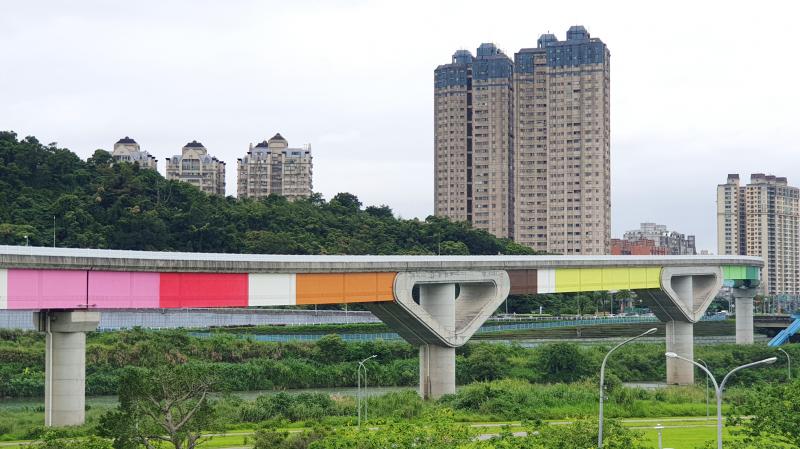
Photo: Han Cheung, Taipei Times
Places like a sports stadium with rainbow colored bleachers perfect for Instagram selfies wouldn’t do it for me either, and it’s pointless to list attractions at the connecting stops that have existed for years. As a history nerd, there was just one place that I really wanted to check out: the Jing-Mei White Terror Memorial Park (白色恐怖景美紀念園區), about a 10-minute walk from Shisizhang MRT Station (十四張).
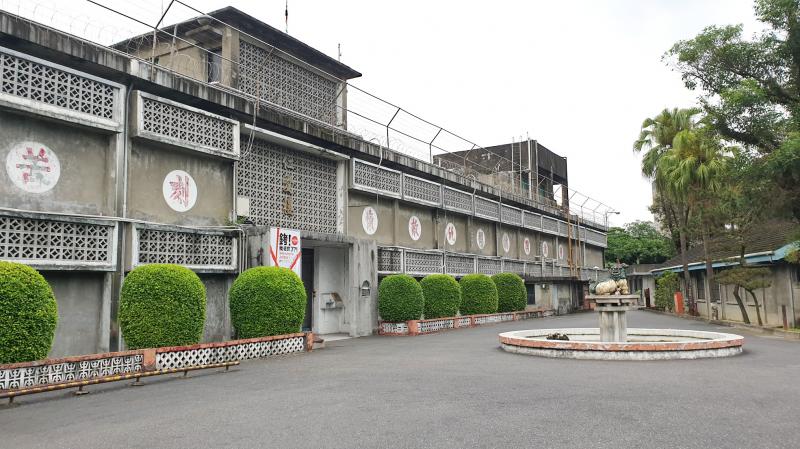
Photo: Han Cheung, Taipei Times
A gray, gloomy afternoon the day after attending my friend’s noise music performance seemed like the ideal time to visit this former detention center for political prisoners during Taiwan’s White Terror era. But to end the day on a lighter mood, I took the train crosstown to Xingfu (“happiness” in Chinese) MRT Station (幸福) in New Taipei City’s Sinjhuang District (新莊) to take a stroll along the Zhonggang Main Drainage (中港大排) park, a once heavily polluted canal turned pleasant riverside walkway that struck me as being similar to, though on a far smaller scale, Seoul’s Cheonggyecheon.
I like exploring random neighborhoods, and I can make a day out of even the most dull, industrial neighborhoods of sheet metal shacks. And these parts of New Taipei City, which seem half stuck in the 1980s but also dotted with futuristic upscale residence towers and malls, make for some fun urban photography.
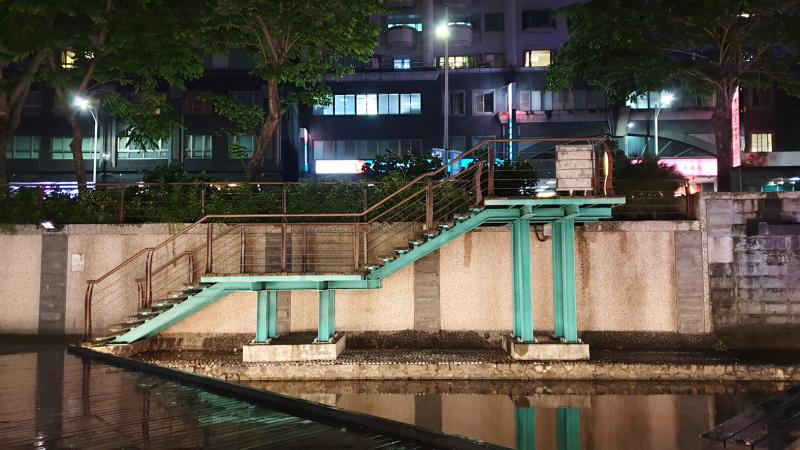
Photo: Han Cheung, Taipei Times
DETAINED FOR SEDITION
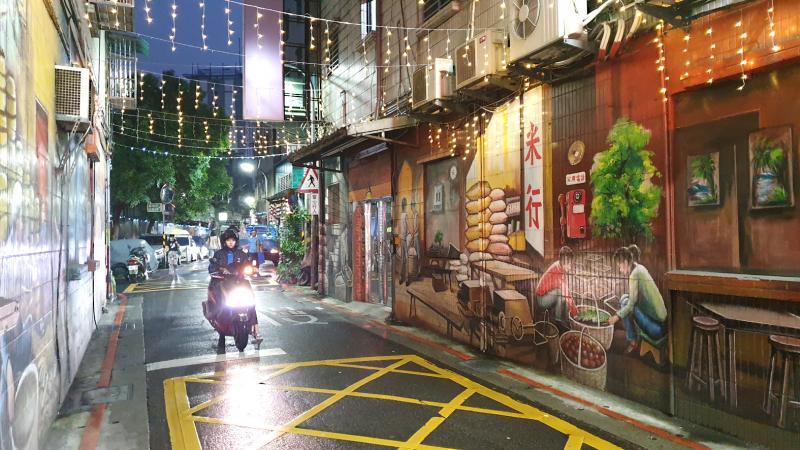
Photo: Han Cheung, Taipei Times
The bright yellow-colored train pierces the gray monotony of the day. I disembark at Shisizhang station, which has an expansive outdoor plaza with a perfect view of the rainbow-shaded train tracks, designed by artist and architect Emmanuelle Moureaux, that stretch along the horizon. I spend some time here clearing my mind, sharing the mostly deserted space with an elderly couple practicing ballroom dancing.
The area leading up to Jing-Mei White Terror Memorial Park, with its MRT depot, car repair shops and recycling centers, is quite desolate. There’s one commercial street lined with eateries and factories, and from the side alleys one can see the prison’s towering concrete walls protected by razor wire.
The park is especially eerie today as it starts to drizzle. On top of that, I was dive-bombed by a nesting Taiwan blue magpie.
Expect to spend up to two hours here browsing the numerous interactive exhibits on the political victims during Taiwan’s 38 years of martial law, with special displays on freedom of speech and children’s rights.
I’ve visited Phnom Penh’s Tuol Sleng Genocide Museum and Hanoi’s Hua Lo Prison, and while far worse things happened in these two former detention centers, the atmosphere and sights are comparable.
However, while these places are among the top attractions of their cities, the Jing-Mei White Terror Memorial Park doesn’t see many visitors even when there isn’t a pandemic. While I do like the solitude, the site has tons of tourism potential that is not being tapped into — most notably the lack of English-language information.
Aside from grey concrete and propaganda signage, the only color here is that nostalgic shade of green often found in old structures, coating the windows, doors, even furniture and machines. The military courts where people could be convicted of rebellion just for insulting former president Chiang Kai-shek (蔣介石) have been restored, while chains and shackles remain hanging from the walls of the detention cells. Even after five years of writing about Taiwanese history, I learned countless new names and incidents, and I was especially intrigued by the section on children of political prisoners who grew up in jail.
As it starts to get dark, I leave the land of sorrow and head towards happiness.
ON HAPPINESS ROAD
“The next stop is Happiness,” the broadcast system announces. I’m sure many people travel to this stop just to hear these words, as it is the Chinese name of Autumn’s Concerto (下一站,幸福), a wildly popular idol drama from 2009. The multiple award-winning animated feature On Happiness Road (幸福路上) is also set in this area, where Xingfu Road (幸福) is the main drag.
Everything has been transported back into time, with the kind of mom-and-pop shops and non-chain grocery stores that make it feel even older than Taipei’s Wanhua District (萬華). I wonder how the MRT’s arrival will change this.
Fushou Street (福壽街) is a dizzying lane of stalls and eateries, each with their big bright signs In between the noisy streets is the Renai Borough painted alley (仁愛里彩繪巷). These “painted communities” are popping up all over Taiwan to attract those seeking their next Instagram masterpiece, but this one is pretty tasteful. Nothing outlandish or kitschy, just colorful murals depicting the area’s past scenery such as old theaters and rice paddies. It’s worth exploring the narrow pathways even at night.
I soon reach the Zhonggang Main Drainage. It’s probably a good thing I came here at night, as the space is adorned with cutesy murals and decorations that have become the bane of my existence traveling in Taiwan. Other than that, it’s quite wonderful. The canal is sunken quite far below street level, effectively shutting out bright lights and the noise from the busy routes above. The southern half features neon-lit angled pathways and foot bridges, while the northern part is more of a standard riverside walkway. The entire route is about 2.3km long, although there’s a portion in the middle under construction until July.
The drainage canal was built in 1989 to relieve flooding in the area, but due to the neighborhood’s high population density it became so polluted people called it the Black Dragon River (黑龍江). The government cleaned it up in 2011, and today fish can be seen in the clear waters even after dark.
The canal terminates in the north at the Western main line, where one can choose to walk up the stairs normally or half-bounce across an amusing floating walkway to shore. One can keep following the river north, but there’s little of interest unless you like furniture depots and indoor shrimp fishing.
From here, I hop on the Taiwan Taoyuan International Airport MRT line to get back to Taipei. Having not expected much, it was a pleasant way to spend the afternoon. As we wait for it to be safe to travel abroad again, it’s often easy to forget that there’s still uncharted territory right in one’s backyard.
>> Jing-Mei White Terror Memorial Park is located at 131 Fusing Rd, Sindian District, New Taipei City (新北市新店區復興路131號). Telephone: 02-2218-2438, admission is free.
>> The Renai Borough painted alleys are centered around Ln 132, Fule St, Sinjhuang District, New Taipei City (新北市新莊區福樂街132號), while the Zhonggang Main Drainage runs along Jhonghua Rd (中華路), about 100m to the west.

On the final approach to Lanshan Workstation (嵐山工作站), logging trains crossed one last gully over a dramatic double bridge, taking the left line to enter the locomotive shed or the right line to continue straight through, heading deeper into the Central Mountains. Today, hikers have to scramble down a steep slope into this gully and pass underneath the rails, still hanging eerily in the air even after the bridge’s supports collapsed long ago. It is the final — but not the most dangerous — challenge of a tough two-day hike in. Back when logging was still underway, it was a quick,
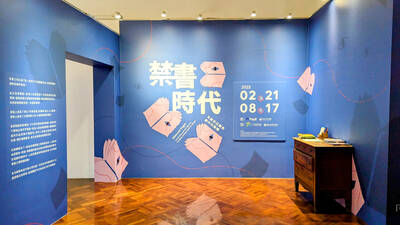
From censoring “poisonous books” to banning “poisonous languages,” the Chinese Nationalist Party (KMT) tried hard to stamp out anything that might conflict with its agenda during its almost 40 years of martial law. To mark 228 Peace Memorial Day, which commemorates the anti-government uprising in 1947, which was violently suppressed, I visited two exhibitions detailing censorship in Taiwan: “Silenced Pages” (禁書時代) at the National 228 Memorial Museum and “Mandarin Monopoly?!” (請說國語) at the National Human Rights Museum. In both cases, the authorities framed their targets as “evils that would threaten social mores, national stability and their anti-communist cause, justifying their actions

In the run-up to World War II, Admiral Wilhelm Canaris, head of Abwehr, Nazi Germany’s military intelligence service, began to fear that Hitler would launch a war Germany could not win. Deeply disappointed by the sell-out of the Munich Agreement in 1938, Canaris conducted several clandestine operations that were aimed at getting the UK to wake up, invest in defense and actively support the nations Hitler planned to invade. For example, the “Dutch war scare” of January 1939 saw fake intelligence leaked to the British that suggested that Germany was planning to invade the Netherlands in February and acquire airfields
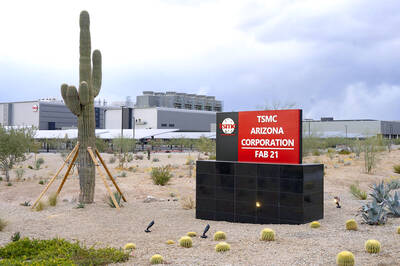
Taiwanese chip-making giant Taiwan Semiconductor Manufacturing Co (TSMC) plans to invest a whopping US$100 billion in the US, after US President Donald Trump threatened to slap tariffs on overseas-made chips. TSMC is the world’s biggest maker of the critical technology that has become the lifeblood of the global economy. This week’s announcement takes the total amount TSMC has pledged to invest in the US to US$165 billion, which the company says is the “largest single foreign direct investment in US history.” It follows Trump’s accusations that Taiwan stole the US chip industry and his threats to impose tariffs of up to 100 percent